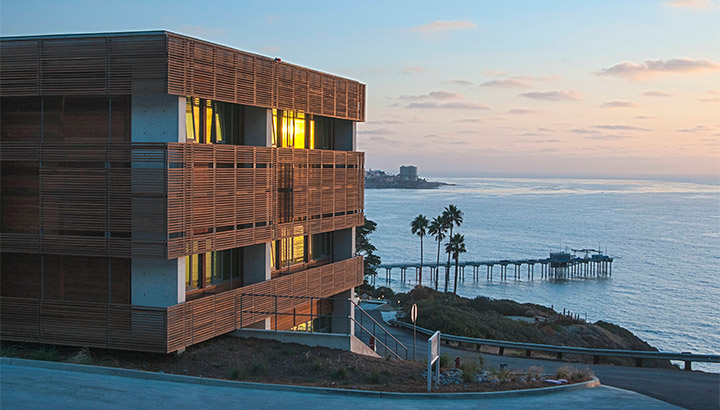
By:
- Mario Aguilera
Published Date
By:
- Mario Aguilera
Share This:
Scripps Oceanography Laboratory Building Awarded LEED Platinum
First laboratory building at UC San Diego to achieve status

The Marine Ecosystem Sensing, Observation and Modeling (MESOM) Laboratory at UC San Diego's Scripps Institution of Oceanography has been awarded Leadership in Energy and Environmental Design (LEED) Platinum rating by the United States Green Building Council. MESOM is the first laboratory building at UC San Diego to achieve LEED Platinum status.
The MESOM Laboratory building is a national and international resource for marine ecosystem, climate modeling, and near-shore oceanographic research for Scripps Oceanography and other ocean science organizations. The building was designed to bring together Scripps scientists from multiple disciplines to develop new sensors that will provide the data to integrate observations and predictive models of California’s near-shore waters and coastal ecosystems and their responses to climate change.
“The LEED Platinum recognition of this new UC San Diego laboratory building at Scripps Institution of Oceanography attests to the university’s active commitment to bringing the best green practices to this campus,” said UC San Diego Chancellor Pradeep K. Kholsa. “Obtaining this achievement further emphasizes our testament to sustainability in our housing, teaching, and research laboratory buildings.”
The new facility further enables Scripps scientists to build upon a long history of successful research on marine ecosystems and their response to climate variability and change and provides the scientific foundation for marine ecosystem-based management. Leveraging Scripps’s longtime experience in marine ecosystems research through existing programs such as the California Cooperative Oceanic Fisheries Investigations (CalCOFI) and the Cooperative Institute for Marine Ecosystems and Climate program (CIMEC) and through close ties with NOAA’s Southwest Fisheries Science Center enhances research programs on ecosystem observation and forecasting for the California Current and beyond. The MESOM Laboratory enables these efforts to become models for understanding processes not only in the Pacific, but also across all of the world’s oceans. The results of the research conducted in the MESOM Laboratory are providing the framework for new approaches to ecosystem-based management and resources not only in the State of California, but nationally and internationally.
“I’m extremely grateful to the leadership and building teams and all our supporters for making this laboratory building a reality in sustainability worthy of LEED Platinum status,” said Margaret Leinen, director of Scripps Institution of Oceanography and UC San Diego vice chancellor for marine sciences. “This new building is already optimizing opportunities for multidisciplinary research for the benefit of society and the environment."
The building was designed by THA Architecture, Inc. and constructed by Rudolph and Sletten general and engineering contractors. The university and its contractors concentrated on incorporating the most stringent sustainable practices into the facility, focusing on six major areas: sustainable sites, water efficiency, energy and atmosphere, materials and resources, indoor environmental quality, and innovations in design.
“It is extremely difficult to achieve LEED Platinum status on a laboratory building and the MESOM Laboratory is one of the few in the country to earn this rating,” said William Joel King, assistant vice chancellor and campus architect for Facilities Design and Construction at UC San Diego. “This was an extraordinary accomplishment and we are very proud of our team’s efforts on this project.”
Locally, the MESOM Laboratory has been recognized for its green building features with the Award of Merit in the Sustainable Technology category by the American Society of Civil Engineers and a Sustainable Communities Champion Award by San Diego Gas & Electric.
In light of the University of California’s emphasis on capital projects to address undergraduate enrollment growth and California’s recent budget constraints, federal funds helped UC San Diego to fully realize the vision of the new MESOM Laboratory. The Department of Commerce/National Institute for Standards and Technology (NIST) contributed $12 million toward the total project cost of approximately $26.5 million, with the balance provided by Scripps Oceanography and UC San Diego. The MESOM Laboratory enabled Scripps to consolidate researchers from a variety of disciplines —who otherwise would be split among five or more different buildings — into a single dedicated facility to promote more productive interactions.
“In less than a year, the MESOM laboratory has merited LEED Platinum status, a distinction which is extremely difficult for any facility to achieve, and much more so for a working laboratory. This recognition underlines the high quality design and planning—and commitment to the environment—that went into MESOM,” said Willie May, associate directory for Laboratory Programs, National Institute of Standards and Technology. “NIST is very proud to have played a role in making this facility possible.”
It has been 33 years since a new (non-replacement) state-funded building was constructed on the Scripps campus, and 10 years since the last research building was completed.
Share This:
Stay in the Know
Keep up with all the latest from UC San Diego. Subscribe to the newsletter today.


